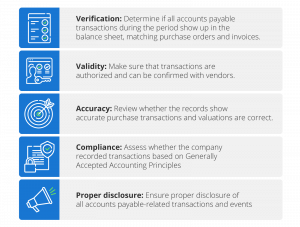For accounts payable teams, effortlessly sailing through audits sounds like a dream. But if you have a manual accounts payable process with mountains of paperwork, audits might fill your AP team with dread.
Not only are audits stressful, but they can be time-consuming and disrupt day-to-day responsibilities. Nevertheless, detailed periodic audits by an independent auditor are inevitable for a high-risk department like Accounts Payable.
Instead of facing restless nights, there’s a better way. In this blog, we’ll explore how to prepare your accounts payable department for the rigor of an audit and simplify your audit approach with accounts payable automation.
Key Risks in Accounts Payable
To ensure accurate record keeping for payables, the amounts your company owes, an AP audit is standard due diligence. AP audits are irreplaceable whether you have a manual or automated AP process. The primary purpose of an accounts payable audit is to ensure your operational and financial affairs are in order.
Since payments for goods and services originate from AP, the department is a prime target of fraudsters. Audits put current processes under review, helping you detect fraud and evaluate the efficiency of controls. Nearly half of fraud cases in the 2022 Association of Certified Fraud Examiners Report happened because of lack of internal controls or an override of existing controls.
Common issues that auditors are looking for include:
- Duplicate payments
- Payments made to inappropriate vendors
- Missed or late payments that may incur penalties and unfavorable terms
- Unrecorded payables
- Intentional understatement of accounts payable to show a higher net income
- Fraudulent transactions perpetrated by internal and external parties
- Internal control deficiencies in segregation of duties, reconciliation practices, and payment processing approval
Objectives of an Accounts Payable Audit
Auditors perform checks on accounts payable to determine the following qualities.
Audit tests vary depending on the size and nature of the organization, though they typically fall into two categories: substantive tests or tests of internal controls. Substantive tests check accounting records, whereas internal control tests look at processes designed to avoid or find misstatements. Companies should, ideally, conduct an audit at least once a year, though they may also occur after significant changes in software or auditing standards.
AP audits are optional for smaller companies, but large organizations don’t have a choice. In the US, audits are mandatory for public companies due to the Sarbanes Oxley Act, which requires an Internal Controls Report to show sufficient controls and financial data accuracy.
What Happens in an Accounts Payable Audit
While specific AP audit procedures may vary, audits typically include these steps:
1. Scope of Audit
Before the audit starts, stakeholders, including managers and supervisors, schedule a meeting with third-party auditors to plan the process. This meeting discusses the scope and the outcomes expected from the audit. Auditors use information from this meeting to plan the actual audit process. Companies also receive an accounts payable audit checklist that outlines documents needed for the audit fieldwork and audit steps like comparing balances, matching invoices, and checking for fraud.
2. Conduct audit fieldwork
Audit fieldwork includes observing business processes to check for operational risks, while inspecting transactions and records for mistakes or fraud. Documentation under review may include financial statements, management reports, purchase orders, sales invoices, general ledgers, vendor contracts, and other supporting documents. Auditors may also send confirmations to verify transactions with vendors and request additional documentation for unusual transactions.
3. Exit interview and audit report
Exit interviews allow auditors and the management to discuss the feedback and issues identified during the fieldwork. Discussions during this meeting influence the final audit report. Auditors then summarize and compile detailed findings into a final audit report.
4. Respond to audit findings
After receiving the report, the management should respond to the findings and recommendations in writing. This response should indicate the company’s plan to solve the issues identified and a timeline for implementing the solution.
Improve Accounts Payable Audit Readiness With Automation
Automating the procure-to-pay cycle can speed up the overall process and make sure that information is kept securely while meeting compliance requirements. Additionally, automated systems generate reports on demand, which makes it easier to track down relevant information quickly when auditors come asking for it. Eliminating manual processes results in fewer interruptions of daily tasks, while improving the consistency and accuracy of the audit procedure.
Here are a few of the main benefits of deploying automation for audit purposes:
- Enjoy cost savings of 89%
- Single source of truth – Improve accessibility of all documentation required for an audit. Streamlined documentation workflows are stored in a centralized repository
- Resolve questions quickly – Offers accurate, timely data to respond to questions, for example through immediate insights into invoices, purchase orders, and goods received notes
- Strengthen internal controls – Companies can embed automatic controls into the system that do not require human judgment. AI and machine learning also look for problematic areas and identify red flags.
- Facilitate a wider audit scope or cover multiple geographies
- Reduce Data Entry Errors – Intelligent automation enables straight-through invoice processing. Driving down the number of manual touchpoints eliminates human error, which begins a virtuous cycle. Fewer errors in AP means fewer items to investigate, respond to, and resolve during the audit. This may also help minimize material errors in financial statements.
- Free up time for strategic thinking
AP audits can send AP teams into a tailspin, especially for companies that process thousands of invoices. However, with an intelligent system in place, you can quickly identify discrepancies and correct them before the auditor arrives. Even if issues crop up during the AP audit process, stakeholders have a clear audit trail to search. Thanks to automation, AP teams can face audits with preparedness and confidence.




